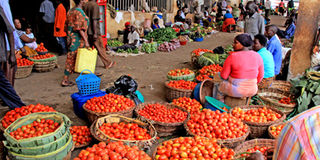5 per cent of Uganda’s consumed food stuffs imported - Ubos

Traders sell produce in Mbale Market in early February. Despite Uganda being regarded amongst the most food-secure nations, the country still imports food, including what's grown domestically on large scale.PHOTO/RACHEL MABALA
What you need to know:
- A report by Ministry of Finance indicated that Uganda spends substantial sums on vegetables, roots and tubers, which during 2019, cost the country close to $18m (Shs49b).
A report by Uganda Bureau of Statistics (Ubos) has shown that Uganda imported at least 5 per cent of its food items between 2013 and 19.
The report, titled Uganda Food Balance Sheet, also indicates that the country was able to produce 95 per cent of all food consumed within.
This, the report says, makes Uganda one of the most food-secure countries in East Africa.
During the period, according to the report, starchy roots, which averaged at between 120.7 kilogramme and 103.2 kilogrammes, contributed the biggest percentage of imported food items while vegetables oil products and fish supplies contributed an average of 11 per cent per person annually.
A report by Ministry of Finance indicated that Uganda spends substantial sums on vegetables, roots and tubers, which during 2019, cost the country close to $18m (Shs49b).
Some experts, such as Ms Victoria Ssekitoleko, the Private Sector Foundation Uganda vice chairperson and president of International Women in Coffee-Uganda Chapter, have previously wondered why Uganda imports some food items such as vegetables that are produced here.
The Ubos report also indicates that food security stands at 95 per cent with dietary consumption of above 2,000 grammes per day.
However, daily supply proteins, according to the report fluctuate with the least per day input standing at 48 gramme while the highest stood at 57 grammes during the period.
Supply of per capita fats has been above 50 grammes per day with the highest supply of 56 grammes per day coming between 2014 and 2017.
Starchy roots contributed the most food between 2013-2018 with an average of 120.7 and 103.2 kilograms per person yearly while vegetable oil products and fish supplied least food each contributing an average of 11 per cent per person yearly.
Cereals and starchy roots were the most important foods, contributing an average 30 per cent and 16 per cent respectively of all calorific supply.




